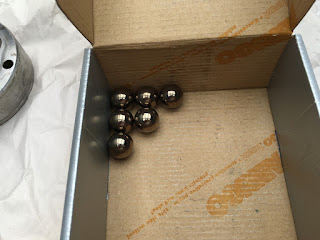Back in 2012 I was trying to diagnose a driveline related shake in Isolde. Driveline shake is one of the most difficult problem to diagnose in my experience. There are many potential causes, from the most simple to the most complex, and from the most obvious to the most obscure. What made this especially was for about 7 years I was very overwhelmed with other things in life and have not driven Isolde much. Normally I am very in tune with my vehicles. This lapse in use I would ending paying a price.
the CV joints were replace in February of 2012
there were no sign of grease leak on all 4 CV joints
the original axles removed from the vehicle
I marked each drive shaft with cable tie so they may be reinstalled back to the same side so the twist of the axle is not reversed; I improvised a pulley puller to pull the CV joints off the drive shafts without applying force to the bearing balls or the races
this is one of the 4 original CV joints from Isolde which I thought were bad; this photo was taken in 2012 after I cleaned the grease off them; they are all Lobro
Reexamination of the Original CV Joints Two Days Ago:
All the photos below are take this week when I decided to re-examine the conditions of these 4 CV joints.
I kept track of where each of the CV joints came out from - this is the inside joint at the passenger side
I keep them in the boxes of which the new GKN brand joints came in; note that GKN is now same as Lobro
the factory CV boots were in excellent condition
note the extra ring dam inside to prevent the hot grease from migrating into the boot
the box the new GKN CV boots came in - made in Italy; I remember it is not as substantial as the original boot and seems to be smaller
Below are a series of photos of the original Lobro CV joint details.
factory VW markings - still have the W. Germany (before the fall of the wall)
this side faces the drive shaft for this particular joint
this side faces the flange for this particular joint
this side faces the drive shaft - note inner star shape race has no chamfer on the corners; note also the ball bearing cage
this side faces the flange - not eht inner star shape race has chamfer on the corners; note also the ball bearing cage has a bevel and a chamfer
All the photos below are taken two days ago when I went back and reexamined all 4 original CV joint wear in detail. I only took photo of the most worn bearing races. You can see that they are in excellent condition with only about 67500 miles on the vehicle.
RI = passenger side inner
RO = passenger side outer
LI = driver side inner
LO = driver side outer
RI inner ball hub
RI outer ball hub
RI ball bearings
RI part marking
RO CV kept by the cable ties as how it was removed from the vehicle
RO outer bearing hub
RO inner bearing hub
RO ball bearings
LI CV as how it was removed from the vehicle
LI ball bearings
LI inner bearing hub
LI outer bearing hub
LI outer bearing hub - another bearing race to the left
LO CV as it was removed from the vehicle
LO outer bearing hub
LO inner bearing hub - the bearing race on the right is the worst of all 4 CV joints; this is the only one that has pitting
LO inner bearing hub - other bearing races have very little wear
update - 16.04.06:
With the great weather outlook I want to get the show on the road to resolve my suspicion of the new CV joints are the cause of the mild driveline surge and tuck at highway speed. I have been torturing myself over the right grease lubricant. I am always been a skeptic of the lubrication industry high quality product line. In certain application I would follow the car manufacturer's recommendation to a tee. With the CV joint service being so painful process because of the mess it involves, one naturally gravitate to think that I should get the best lubricant money can buy. Bingo, that is what the industry want you to think. While the "best" lubricant may cost $8 or $15 more than the generic stuff starting at $6.99, that is a whopping 214% or 314% more respectively.
I reviewed the basic compositions of the expensive and generic products and the basic ingredients are the same. Yes, the boutique brands tout this and that wonderful proprietary additives, or synthetic. Most of them also tout high drop point. Is high drop point always a good thing? I doubt it. I can see they are good choice for the high performance dune buggy racers for the extreme stress and high desert like temperature these events tend to take place.
I mining equipment can use $20 a 5 gallon bucket of grease I don't see why I have to spend $25 on a 14oz tube.
Since I had a T2 VW bus back in the early 80s I have been using this Sta-Lube Moly-Graph EP grease
I decided to stick with it and picked up these (except the CV joint) from local Napa. It is my lucky day. Not just they have everything I was looking for, I found a very affordable grease gun - the cheapest one of the bunch. Both the grease gun and the moly grease are on sale, and I left the store with just a $33 total bill.
this is the bearing puller I used





































No comments:
Post a Comment